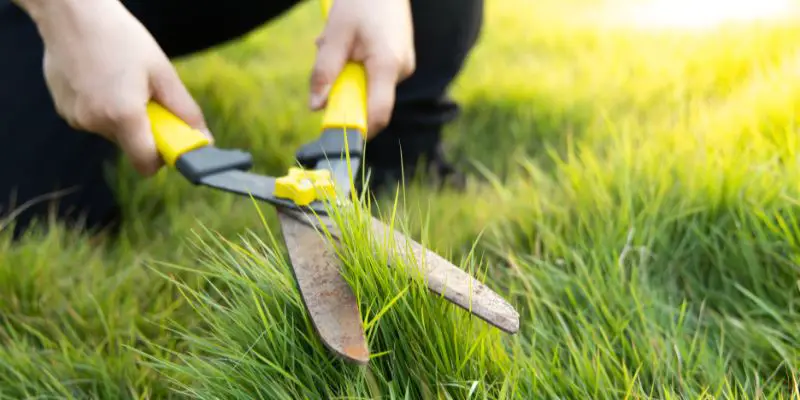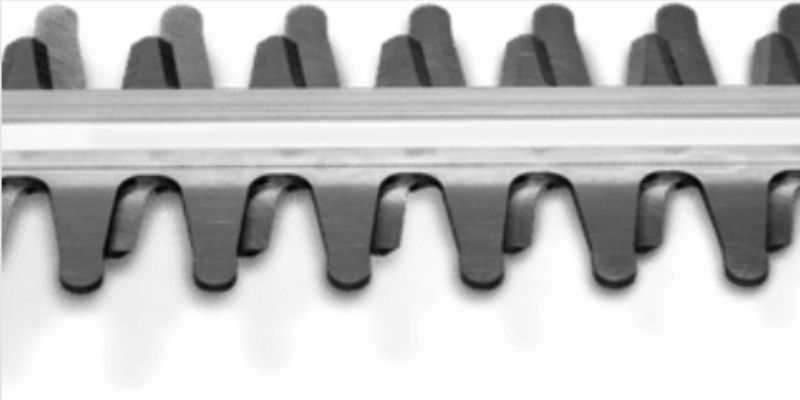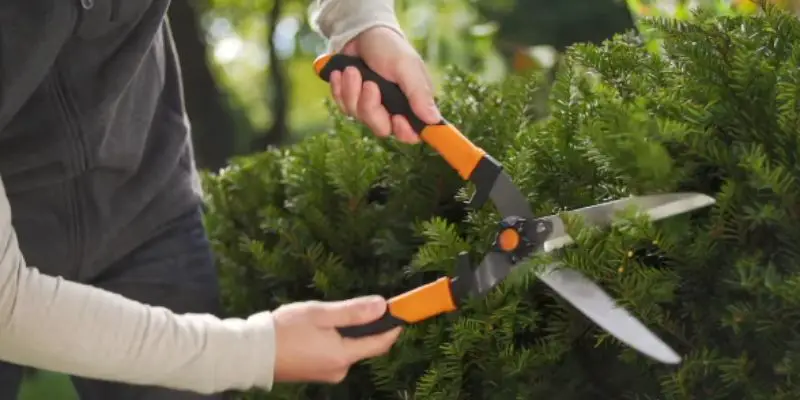For homeowners with lawns and gardens, keeping the grass and bushes neatly trimmed is an important maintenance task. While lawn mowers are the most common tool for cutting grass, hedge shears provide a useful alternative for small areas. However, using the wrong tools can damage your lawn and plants. So an important question is – can I use hedge shears to cut grass?
The short answer is yes, hedge shears can be used to trim grass in certain situations. Hedge shears are designed for pruning shrubs and thicker stems, but they can also cut grass blades if used properly. They work best for small patches of grass rather than large lawns. The limitations of hedge shears mean they should not completely replace lawn mowers for grass cutting. But hedge shears offer benefits such as portability and precision for trimming in tight spaces.
When Are Hedge Shears Useful for Cutting Grass?
Here are some of the main situations where using hedge shears to cut grass can be advantageous:
- Tight spaces – Hedge shears are more maneuverable than lawn mowers for trimming around obstacles like trees, fences and flower beds. Their short blades allow precise edging.
- Small areas – For small patches of grass and weeds, hedge shears provide an easy way to maintain the area without getting out the mower.
- Inaccessible areas – Hedge shears enable you to reach under bushes and other hard-to-access spots to remove unwanted grass and weeds.
- Dry grass – On growth that is dry, dormant or straw-like, hedge shears can cut through the tough blades more easily than a mower.
- To neaten edges – Use hedge shears to precisely trim borders and create clean lines along driveways, sidewalks and gardens.
- As an emergency back-up – When your mower breaks down or the grass gets too long between mowings, hedge shears let you quickly tidy up the lawn.
So in summary, hedge shears excel at precision trimming of grass in areas a lawn mower struggles to reach. They also provide a handy portable backup option when needed.
Tips for Cutting Grass with Hedge Shears
While hedge shears can cut grass, they require some care and the right technique to avoid damaging the lawn:
- Work in small sections – Cutting grass with hedge shears is slow going, so divide the area into smaller, manageable portions.
- Use by-pass blade shears – By-pass blades similar to scissors or pruning shears work better than anvil blades for cutting grass. Look for extra sharp blades.
- Cut at an angle – Position the hedge shears at a slight angle rather than straight across for a cleaner cut of the grass blades.
- Maintain sharp blades – Sharpen your hedge shears regularly for easier cutting. Blunt blades will tear rather than slice the grass cleanly.
- Avoid wet grass – Cutting wet grass sticks to the blades causing clumping. Let grass dry out after rain or watering.
- Remove debris – Built up debris between the blades hinders cutting, so wipe and clean your shears frequently.
- Alternate direction – Change the direction that you cut in with each pass to avoid ruts and lines in the lawn.
- Watch your step – Be careful where you place your feet when moving around to avoid creating dents or damaging the turf.
- Don’t overdo it – Remove only the top growth rather than cutting grass down to the soil level to maintain lawn health.
Pros of Using Hedge Shears for Cutting Grass
Within their limitations, hedge shears can be a useful grass cutting tool in the right circumstances. Some of the benefits include:
Portability
Hedge shears are lightweight and easy to maneuver compared to a lawn mower. Their compact size makes hedge shears highly portable so you can cut grass anywhere.
Precision
The short blades of hedge shears allow meticulous trimming around obstacles and borders. You can neatly edge along garden beds and hard surfaces.
Accessibility
Hedge shears let you trim grass in awkward spots like under bushes, behind sheds and around tree roots that are inaccessible to lawn mowers.
No fuel required
Without an engine or battery, hedge shears don’t require any fuel source to operate. You simply cut by hand power whenever needed.
Quiet
Using hedge shears creates little noise compared to the roar of a mower engine. They allow you to trim early mornings or evenings without disturbing the neighbors.
Low maintenance
Aside from occasionally sharpening the blades, hedge shears are simple to maintain. You avoid the oil, filters, belts and maintenance of motorized lawn mowers.
Cost effective
Buying hedge shears is far cheaper than purchasing a lawn mower. For occasional trimming, hedge shears get the job done without a big investment.
Environmentally friendly
With no emissions or oil leakage, hedge shears are much more eco-friendly than conventional fuel mowers for cutting grass.
Cons of Cutting Grass with Hedge Shears
However, there are also some downsides to using hedge shears for your lawn:
Time consuming
Cutting anything more than small patches of grass with hand shears is extremely slow and laborious compared to using a power mower.
Not for large areas
Don’t attempt to cut a whole lawn with hedge shears. They lack the width and power for efficiently mowing large grass areas.
Can damage lawn
Incorrect hedge shear use risks tearing the grass rather than cutting it cleanly. This can harm the lawn’s health and appearance.
Requires physical effort
Hand cutting grass with hedge shears is physically demanding. It can strain your hands, arms and back, especially on big jobs.
Limited blade life
The grass and dirt wears down hedge shear blades faster than pruning shrubs. Sharpening or replacing blades regularly adds hassle.
Poor results on long grass
Hedge shears struggle to cut through tall, thick grass growth cleanly. You may need multiple passes.
No collection
Unlike a lawn mower, hedge shears do not collect grass clippings as you cut. You either need to rake these up or use a catcher.
Difficult on wet grass
Trying to cut wet lawn growth clogs and jams the hedge shear blades with clippings. Letting grass dry out first is best.
For anything beyond occasional touch-ups, the effort and time required make hedge shears impractical for cutting whole lawns. Large areas, long thick grass and frequent mowing are better left to proper lawn mowers. But hedge shears serve as handy backup for maintenance in between mows.
Hedge Shears Features for Grass Cutting
While all hedge shears can cut grass in a pinch, certain features make some models better suited than others:
- Lightweight – The lighter the shears, the easier they are to wield for extended grass trimming
- Short blades – Around 4 to 6 inches long to provide precision edging ability
- Bypass blades – Scissor-like cutting action slices cleanly versus tearing
- Sharp cutting edges – Ensures a clean cut rather than shredding the grass tips
- Comfortable handles – Cushioned grips reduce hand strain for repetitive cutting motions
- Adjustable handle – Can adapt the angle to suit your grip position and cutting style
- Rust resistant – Important for the wet grass conditions hedge shears will face
- Grass deflectors – Clip-on deflectors keep long clippings from jamming the blades
Look for reputable brands like Felco, Corona and Fiskars for quality construction and cutting performance. Cleaning grass buildup and lubricating joints also helps maintain your hedge shears in proper working order.
How to Cut Grass with Hedge Shears
Follow these steps for best results when using hedge shears to cut grass:
- Pick your spot – Choose a small, defined area of lawn rather than tackling a whole yard.
- Remove debris – Clear away fallen leaves, twigs and other objects that may hinder clean cuts.
- Let grass dry – For easier cutting, allow any moist grass to fully dry out first.
- Start edging – Trim a clean edge along borders like sidewalks, gardens and driveways.
- Work in sections – Divide the area into smaller sections to methodically work through.
- Cut at an angle – Position shears at a slight angle rather than straight across for cleanest cuts.
- Adjust hand position – Alternate between overhand and underhand grip to distribute strain evenly.
- Make successive passes – On longer growth, cut in layers with multiple passes from different directions.
- Clear clippings – Frequently wipe away grass debris building up on the blades.
- Stop before soil – Only cut the grass blades, not down to bare soil, for lawn health.
- Sharpen when needed – Keep hedge shear blades sharp for optimal cutting performance.
- Finish edging – Make a final edging pass around borders for straight, defined lines.
- Sweep or rake – Remove the grass clippings left on the lawn unless you want them to naturally decompose and return nutrients to the soil.
- Check your work – Stand back and inspect for any remaining long patches you may have missed.
- Touch up missed spots – Make additional focused cutting passes over uneven areas needing more trimming.
- Clean the blades – Carefully wipe away any grass and dirt stuck to the hedge shears after finishing.
- Apply lubricant – Put a drop of light oil or spray lubricant on the hedge shear joints to prevent rust.
- Store properly – Place back in storage out of weather when not in use to maintain good condition.
- Sharpen regularly – Hone the hedge shear blades as needed to keep a sharp cutting edge.
- Replace damaged parts – Have worn or damaged components like blades and handles replaced.
Following these hedge shear grass cutting steps will deliver the best results possible. Though slower than using a lawn mower, hedge shears provide a versatile solution for maintaining your lawn’s appearance in between mows or in places mowers can’t reach. Their precision trimming ability enables neat and tidy lawn edges. Just be realistic about how much time and effort this manual approach requires on anything larger than spot jobs.
Conclusion
Can I use hedge shears to cut grass? Well, hedge shears are a handy grass cutting tool to have on hand for small trimming tasks and precision edging lawn borders. Their compact size provides easy maneuverability around yard obstacles that larger mowers can’t navigate as easily. But attempting to cut whole lawns with hedge shears would be extremely time consuming and labor intensive.
Used judiciously for touch ups between mows or on patches inaccessible to your mower, hedge shears enable careful grooming of your lawn’s edges and hard-to-reach spots. Just take care not to scalp or damage the turf. Maintaining sharp hedge shear blades and letting grass dry out makes the cutting process much smoother as well.
So in situations where a quick trim rather than full lawn mowing is needed, hedge shears can certainly provide a useful grass cutting solution when applied properly. They serve as an ideal secondary accompaniment to keep your lawn borders looking neat and tidy between regular lawn mower use on the rest of the grass area.
Also read:
Best Electric Hedge Shears – Top 6 Reviews and Buying Guide
Best Rated Battery Powered Hedge Trimmer – Top 8 Reviews
Can I Use Hedge Shears To Cut Grass? Frequently Asked Questions
Some common questions about cutting grass with hedge shears include:
Should I cut wet or dry grass with hedge shears?
Cutting dry grass is best. Damp and wet grass clumps and sticks to the hedge shear blades. Allow lawn to dry out thoroughly after rain or watering before trimming with hedge shears.
How short can I cut grass with hedge shears?
Don’t cut lower than 2 or 3 inches with hedge shears to avoid scalping the lawn. Remove only the top growth rather than shearing grass right down to the soil level.
Can hedge shears completely replace a lawn mower?
No, the slow pace of hedge shears makes them unsuitable for cutting entire lawns. Use them only for precision edging and trimming small areas that a mower can’t easily reach.
Should I catch the clippings when cutting grass with hedge shears?
You can either sweep up the clippings or allow them to decompose on the lawn. Remove any unsightly large clumps but otherwise clippings can provide nutrients back to the soil.
How often do I need to sharpen hedge shears after cutting grass?
Sharpen hedge shear blades at least annually. But cutting grass wears edges faster than pruning branches so you may need to sharpen them 2-3 times per year.

Michael Glenn is a certified arborist and horticultural expert with over 15 years of experience in the landscape industry. His passion for plants and trees has led him to become a sought-after authority on pruning and trimming techniques. Glenn’s in-depth knowledge of proper pruning methods, timing, and tools has helped countless homeowners and professionals maintain healthy, aesthetically pleasing gardens and landscapes.
In addition to sharing his pruning expertise through practical tips, step-by-step guides, and expert advice, Glenn is also a respected author of pruning tool buying guides. His comprehensive reviews and comparisons ensure readers can make informed decisions when investing in quality loppers, pruning shears, saws, and other essential equipment. With a deep understanding of plant biology and sustainable practices, Glenn’s writing empowers audiences with the knowledge needed to properly care for green spaces.





